The Mindset For Wilderness Hunting
If you are thinking about doing a hunt in Alaska, or if you have ever considered doing a wilderness hunt anywhere, there are certain things that every person should take into consideration. While it may all seem so obvious to someone like myself after 20 plus years of working in Alaska, I find that many hunters I encounter have not mentally prepared themselves for the possibilities that they can really expect to encounter on an actual wilderness hunt. I will be quite honest, I have been amazed time and time again when guys have quit on the first day of hunting in Alaska, at times right in the middle of a stalk, and I have seen hunters laugh about those stories only to find themselves on the verge of giving up shortly thereafter!
The first thing that cannot be overstated about wilderness hunting (that is a hunt that is conducted in a remote area with primitive conditions, in contrast to a hunt in a wilderness area from a lodge or camp with modern accommodations) is most hunters have no experience that has prepared them for such! Hunting whitetails for 40 years in West Virginia hasn’t prepared me for the rigors that can be encountered on a hunt in the Alaska bush. The US Army basic training helped to some degree, and primitive camping in tough conditions helped to some degree, but I cannot stress enough that a mental preparation has to take place in order to not be rattled by what one may encounter in a real wilderness setting.
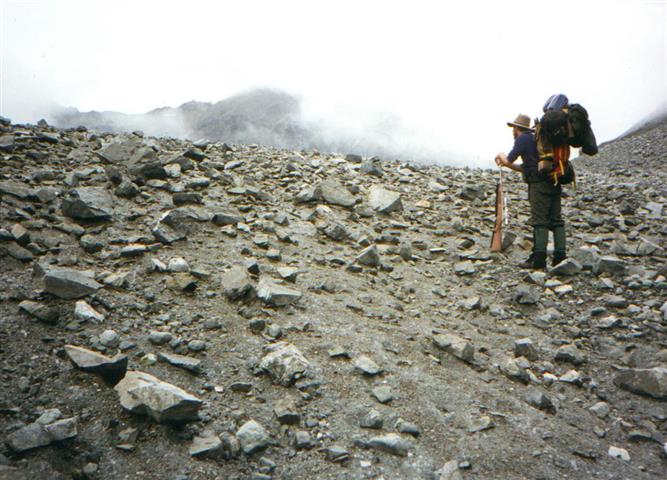
We live in an era when fewer people than ever encounter physically tough conditions, or mentally tough conditions in an arbitrary environment, and with this in mind I think it essential that hunters prep themselves as much as possible for what these type of hunts actually demand. Mind you, a man may come to Alaska tomorrow and have a relatively easy hunt and the same could be said of any wilderness type hunt, but you cannot count on such a ridiculous expectation. It is simply difficult to convey to the potential hunter exactly what they can expect because they have no reference point to judge what we may actually tell them. I can tell a guy that he is going to be in a two man expedition tent, sleeping on the ground, but if he has never had that experience this means virtually nothing to him, or it could mean anything. He may perceive that as a reasonably comfortable idea, or it may sound completely terrifying, but he can’t really know without a comparable experience. So what can we do if someone has no comparable experience? Can they actually be mentally prepared or do they just have to fly by the seat of their pants into the great unknown? The answer to the first part is unequivocally yes, thus you don’t have to be the proverbial guinea pig! The mind-set that is needed for hunting wilderness is one of perseverance and expectation of things being more difficult than anything one has done before, unless perhaps you are a Navy SEAL. This makes me think of this past season (2017) on my first hunt I had a new packer/apprentice who is a long time National Guard service member and a hunter who had hunted Alaska three times already. At the end of the hunt the packer told me that if someone asked him about becoming and Army Ranger, he would tell them to first go apprentice with our outfit, then decide if you still want to be a Ranger. The hunter on that particular hunt told me that the final night we spent climbing back up from a nasty alder covered slope (after losing a wounded bear), then back up 1,000-1,500′ of sheep type slope to get back to camp, was unequivocally the toughest thing he had done in his entire life!
What I have found over the years is that virtually everyone I ever had quit on a hunt actually quit not because they were not physically able to do it, but something snapped mentally. They lost the will to hunt, to endure the difficult conditions and terrain, and while they may have tried to convince me or even themselves that it was physical I never saw any evidence of this, ever! I saw two hunter quit on day one of a sheep hunt the first year I worked as a packer. Granted one gentleman was nice older guy who didn’t have much going for himself physically, he nonetheless still quit on day one rather than saying I will rest and relax for a couple days then try it again, which he had the option of doing. Others have quit after making one unnerving climb, and some have simply quit because they couldn’t stand sleeping in a tent! Some who made fun of these guys ate their humor later on in the field!
I heard a saying probably while I was still in the Army and training with some Marines that the when you thought you could not take another step without simply falling over dead, the Marines could still get five more miles out of you, and I believed this and I have pushed myself in this fashion, praying all the while to not give out, or collapse, but always convinced that I could actually go further. It’s not a position of arrogance, for I know the reality of relying on the strength of God rather than my own abilities, but it is important to believe you can do it. It isn’t mind over matter, because if your body does give out, there you are, it doesn’t matter what your mind says. If you push yourself to extremes before hand you will have a much firmer grasp of your actual limitations and this certainly helps to ease the fear of getting in over one’s head. What I am saying is don’t try to swim the English Channel first if you have never did a half mile swim across the Ohio River!
What is Wilderness
It would seem like an easy question, but a lot of people actually get surprised upon arrival in real wilderness in a place like Alaska. The US Congress ordained that the Department of Interior classify certain pieces of Federal land as “Wilderness” areas and thus they are congressionally designated as such, but this fall completely short of what we are talking about. From what I understand the largest tract of “Wilderness” in the Lower 48 is the Frank Church River of No Return Wilderness on the Salmon River in Idaho, and if I understand correctly it is less than 25 miles across. We have the Cranberry Wilderness in West Virginia and it is 16 miles from one end to the other, but it can be walked across in a day without too much trouble and when you come out of it you are on a well traveled highway. There are tough and dangerous places all over the Lower 48 but there are no 100 mile stretches of wilderness that one can cross without running onto some guy’s ranch, or crossing a barbed wire fence. It simple isn’t like that in Alaska. Visualize the Brooks Range; the northernmost of the major mountain ranges in Alaska; spreading roughly 900 miles from the Yukon border on the east and almost to the Bering Sea in the west. 900 miles and you know how many paved roads cross it? Try zero! The “Haul Road” crosses it as it heads to the Prudhoe Bay oil field but even that is a very primitive gravel road and if you are 200 miles east or west of it then you get the idea. Or do you? Our cabins are roughly 125 miles of the highway system and let me explain it like this; if you found yourself in a survival situation without an electronic beacon, satellite phone or satellite texting device, this is what you could expect. You could figure out approximate direction from sunrises and sunsets though it can be pretty misleading that far north and if you had some idea that you needed to head east to get back to civilization you could make an attempt to go that direction. With or without a map, you would soon discover there are massive glacial rivers that have to be crossed and regardless of what one may have seen on asinine reality TV, crossing a glacial river is potentially deadly. Many larger rivers simply could not be crossed, considering the speed of the current and the fact that even in early August the average temperature of such streams never gets above 45 degrees. When you do the math on hypothermia and 45 degree water it is trouble. In a nutshell you are looking at crossing miles and miles of mountains, glaciers, deadly rivers, wetlands and when you do hit solid ground it is very often so thick in vegetation that it can take a week to cross 10 miles if possible at all. In my mind real wilderness is essentially defined as being a place where you are most likely never going to be able to get out of it alive, with the exception of extremely skilled person with SEAL like training and endurance.
There are so many places in the far north that one can travel a hundred miles or more without encountering any real trace of civilization, and without the proper gear these places are almost always guaranteed to be potentially deadly. Not that you can’t get into danger in non-wilderness places but everything is magnified in real wilderness settings. Slicing a stick of summer sausage with your handy pocket knife can be something that requires an emergency rescue from the Coast Guard and this is only if you have the working equipment to get that signal out, otherwise we are back to potentially deadly wounds.
Wilderness should be understood as being vast in and of itself, so large that when you think of getting out you already have written walking off the list. I don’t always say that this applies, but if you can walk out over the course of a day then at best you are only on the edge of a wilderness area in my estimation, though it can still be trouble. To give you an idea, let me tell you a brief story about the first area I worked in when I got started in the business.
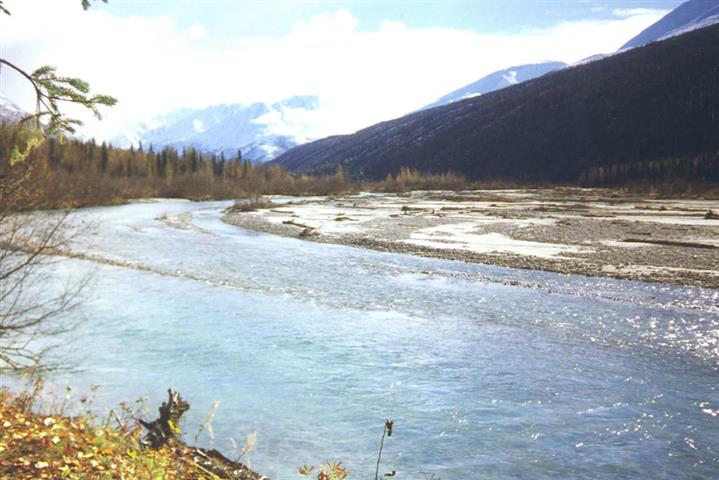
When I started as an apprentice for Master Guide Ed Stevenson in July of 1996 I walked in with his son Ben from the highway system near Talkeetna roughly 58 miles over the course of 3 1/2 days into the Sheep River drainage where Ed was waiting for us. Now this journey was extreme, but also likely impossible if one didn’t already know the country very well, and we basically followed a snowmobile route that Ed used from time to time, but there was no sign of a trail through that very difficult country. If you look at the picture here of Sheep River you can see the height of the mountains and though we came across a pass, we basically started at 500′ elevation came across the top at roughly 3,800’and descended back down to 900′ on the Sheep River. During this trek I literally thought I would die trying to keep up with Ed’s twenty year old son and I was only 30 myself. The thing that I did get from this trip was the conviction that I would probably never come close to such an ordeal again during my career as a guide, especially if I was working for myself! Folks I would still say that this was just the edge of wilderness for the most part, in relation to what you can easily encounter in Alaska. Yet the following year, which would be my first year as an Assistant Guide I encountered what is all too common in Alaska and other wilderness areas; a close encounter with tragedy.
Early in the sheep season a father and his 13 and 17 year old sons came down into the Sheep River valley after having hiked multiple days from the popular recreation area known as Hatcher’s Pass out on the highway system near Palmer. They had probably hiked 40-50 miles when they happened upon the river and for some reason they had planned on crossing it, though their destination of Talkeetna didn’t actually require this. The father had brought a medium pack raft and from what we understand he tied a rope off to a tree and around his waist and began to shuttle loads of backpacks across a channel of water on the nasty Sheep River. Most of this river would qualify as Class III whitewater, full of glacial silt and dangerous piles of pun-gee stick like driftwood and Ed had told me the number one way of dying in the country was to use a rope on a river or stream crossing. It didn’t go well for the father; the raft went out from under him and as the kids scrambled to get the rope undone from the tree he bounced up and down in the 40-45 degree water. Finally they got it loose and dad was swept downstream into oblivion. Three days later Ed’s son Ben was riding up an old pack trail on the other side of the river when he spotted some fabric near the river’s edge and we rode out into an opening and was visible enough for the two young boys to spot him and begin screaming for help. Of course an armada of choppers came in and two weeks later they still had not found the father when I began my final sheep hunt of the season.
I had the story in my mind all season long and I didn’t know by the time I was ending my final hunt that the family had found the father after the State had quit looking and he was recovered from a driftwood pile around a quarter mile below the accident, and even with all of this going on, the reality of wilderness dangers still had not settled into my young, stupid mind! I came off the mountain with a pack loaded to 80 lbs. or so of sheep and gear and proceeded to try to cross the Sheep river roughly 30 miles upstream from where the accident had happened and I ended up going down in 32-33 degree water because I allowed it to go over the top of the accursed hip boots. Forget all the details, the important thing to note was I came very close to meeting the same kind of fate because I ignored certain wilderness rules and yes the wilderness does expect you to keep to the rules! I can never stress enough that real wilderness demands that you take precautions that you might never consider if you are only a half mile from the truck, or hunting the neighbor’s alfalfa fields. It is unforgiving and one can’t afford to keep the same mind-set that you may have at home or in a less hostile environment.
In the long run we must understand that real wilderness is daunting, vast and poses a host of difficulties all of its own making and the hunter must prepare himself mentally that this is a place of extremes, silences that are profound, earth shaking rock slides, avalanches and earthquakes that can rattle anyone’s cage, and situations that have to be endured, rather than running away from.

Extreme Weather
While most people automatically think that Alaska is like Antarctica, there is little similarity, that is to say it isn’t dark six months out of the year and it is not all covered in snow continually with -50 degree temps! That being said, wilderness hunting is continually placing the hunter at odds with the weather and Alaska is no different than other wilderness areas in that regard, though some of the weather in Alaska can certainly be beyond the expectations of the average hunter. I have spent numerous days and nights in a tent with winds in excess of 70 mph and over 100 mph on occasion and I have seen my fair share of things go wrong with the tents, boats, cook shacks, etc.! Imagine a hunter who has actually never spent a single day in a tent in their lives finding themselves dead in the middle of a hurricane force storm on the Alaska Peninsula, or a complete whiteout on top of a snow covered ridge during a spring brown bear hunt in the Alaska Range. One simply has to make the mental decision to take what comes down the weather pipeline with patience or it can drive someone crazy in short order. It is certainly possible to be stuck in a tent on a sheep slope with less than 50 yard visibility for days as the clouds completely sock you in, and it is also very possible that a pilot may not be able to land you in the most optimal place on a beach, or mountain top if the weather doesn’t cooperate. All these things go back to mental preparation; it doesn’t matter how much money you just threw down for this hunt, you are not big enough or bad enough to dictate to the weather or God who says yes or no! My first time out as an Assistant Guide taught me something about the weather and taking a more patient approach. It all boiled down to hunters being impatient and biting at the bit to get up on the mountain, yet it was obvious to me and the other Assistant Guide (who had an extra year’s experience on me) that the clouds were lying heavy in the high valley we wanted to climb up into. We were at 1,900′ elevation and we needed to get up to 4,000′ elevation before we could even begin the mile or so walk across multiple rock slides into the area we expected to camp. The hike was challenging enough for most people on the nicest day, for that matter my first climb into this valley the previous year as a packer had me convinced that the client wasn’t going to survive getting to the 4,000′ mark, which he did, but he quit in the middle of a stalk on a ram the following day! Now we opted to go up in spite of the rain, and cloud cover, and really our decision was based upon the hunter’s anxiety. How did it go? It ended up being over a 13 hour death march, all through the night with our arrival to the camp spot around 5:30 AM. I had a three inch blister on the sole of my foot and I came to the very real conviction that the weather should do the dictating, not the client.
While we generally don’t encounter extreme temps of any sort, wind, persistent rain, and cloud cover always pose potential problems on any given hunt. What can you do to get ready? Well if you don’t have any such experience it would be best to get it somewhere, but if that isn’t a real option for you then you should be ready to allow your guide to make the experienced decisions when facing opposition from the atmospheric conditions! Don’t try to push your guide into taking you out onto a dangerous slope when the visibility is virtually nothing, and don’t argue with a seasoned professional who tells you that brown bear can wind you from a mile away easily with a 30 mph wind blowing the wrong way. Ultimately the weather is much easier to deal with if you have the right gear, and paying attention to an outfitter’s gear list is the first place to start Some experienced hunters can get in trouble by simply thinking they have all the right gear already, and miss something that we may consider critical in our particular area or circumstance. Rain gear comes and goes and people will swear by this for awhile, then that, but it is best to pay careful attention to an outfitter’s recommendation. I much prefer the best outer shells I can afford, lightweight and without any soft texture on the outer surface, since it will eventually soak up water like a sponge. I’m wearing the Arctyrex Ascent Alpha SV rain jacket designed primarily for extreme weather climbing and I carry a Kuiu Chugach rain jacket as a backup. The Kuiu failed miserably during my 3rd year in it, but in all fairness I had never treated it with any proper treatment to restore water repellency. I wear the Kuiu Chugach pants when I wear rain pants, but I am now wearing the Simms G3 Guide Pant as often as I can because it is actually a waist high Gore Tex stockingfoot wader and I wear the G3 Guide Boot in conjunction with it. I can assure you being able to stay reasonably dry is the first step in not breaking down in the field. Let a hunter get his rain gear soaked, then all of his clothes along with it and the emotions quickly take a man into despondency and despair. Honestly it doesn’t matter how prepared you are mentally, if you end up soaked and nothing dry to put on and the conditions outside do not improve, you may have an extended stay in the tent just to be safe. When I tell guys about the Simms waders I know a lot of guys think they are not going to fork over that kind of money for a wading pant that they also have to buy a special pair of shoes to go along with them, but if you are soaked through to the bone and I am dry, you will re-evaluate your philosophy!
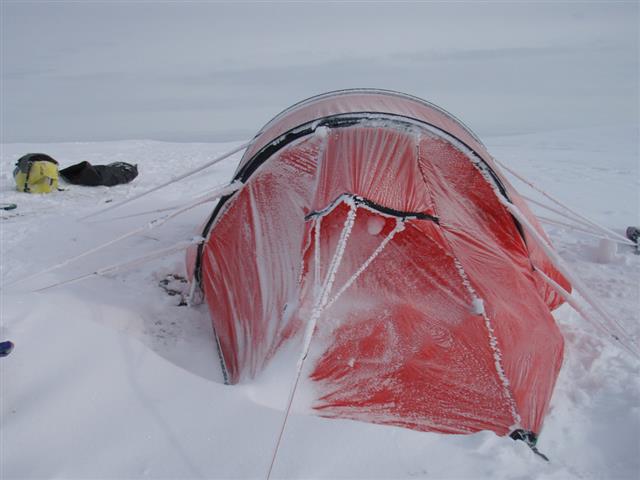
Once again if you have the time to put things to the test, then you should take it. It’s a miserable thing to hunt late September and wake up to a 20 degree morning and find that the 15 degree sleeping bag you purchased is nowhere near warm enough for you, and what’s worse is you live somewhere that you could have spent the night in the backyard just once through the winter and found that out before it was too late. This is one of those items that can really make or break a hunt in the wilderness! Sleeping bags, rain gear, boots, headlamp and the right sleeping pad are all super critical items that one simply can’t skimp on. Some guy wants to waltz into camp with a $5,000 rifle but a sleeping pad from Walmart and after it blows out on the first night he would gladly trade me his rifle for my Thermarest! If you go into a wilderness hunt realizing that the weather could really pin you down for days on end, and you understand that this is the price you may have to pay to hunt such incredible places then you will be making headway in the realm of the mind.
Challenge of the Land
I had an individual come into a camp upon a 5,000′ knob (well above the 3,000′ timberline) a couple of years ago and they were simply accompanying the hunter, and we came in a couple of days before the sheep opener on August 10th. By opening day this individual had expressed the desire to get flown back out to civilization. What was the problem; from everything I could see it was simply wilderness. We were around 150 miles of the grid with miles of endless mountains stretching all around and the simple immensity of it appeared to be overwhelming to him. Cell phones are useless and there is no place to go and when you look all around and realize just how remote a place actually is it can be unnerving to say the least. Another client years ago came all the way from Barcelona Spain to hunt brown bear, knowing that there were no cabins and after one night in a tent was ready to call it quits and go home because of anxiety about being attacked by a bear!
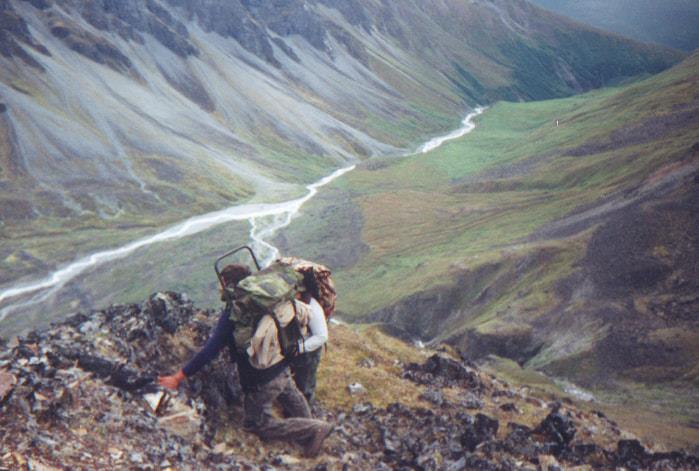
The first hunt that I ever packed on in Alaska ended on day one when a hunter (who told us he had prepped by running with 60 lb. packs and rappelling as a member of the counter terrorism team in the prison where he worked) quit right in the middle of a stalk on a ram, and all he could do was utter irrational sentences about us getting stuck on the mountain. The land was very different for me, growing up in West Virginia I was very accustomed to 60 degree slopes, but they were covered in hardwood forest and there was always a tree to grab on to. In Alaska I quickly realized the slope looked immensely different without any trees and I found that I could easily allow vertigo to get the best of me. Having a fear of heights has always been a reality for me and being next to a sheer ledge of even 100′ is intimidating and certainly something I’ve had to confront. Terrain in Alaska can be simply challenging beyond anything one is used to, especially considering the fact that there are virtually no trails whatsoever in these real wilderness areas. It’s not like Yellowstone, or the Appalachians, laced with Forest Service trails and roads. At times traveling a mile can be something that you simply decide isn’t worth the effort!

We get guys from all parts of the country and world and it is virtually impossible for everyone to get real training on ground similar to what they may hunt in a place like Alaska, but I advise anyone to try to find as difficult terrain as possible to do some real world training. Imagine climbing 2,000′ in elevation in a day just to get into a spike camp for sheep, or even grizzly or caribou. That’s 200 flights of stairs if you can’t 10′ per story in a building, or 250 flights if you count 8′ per story. Regardless of which way you count, how often do you take the elevator instead of the stairs and can you really imagine going up the stairs of the Empire State Building twice in a day, then add 50-70 lbs on your back and cover that stairwell with boulder piles, or better yet just remove the stairs altogether and make the grade 50-70 degrees and add the boulders and loose scree and then you are getting the idea! I have seen my fair share of guys who make one climb only to realize they bit off more than they want to chew!
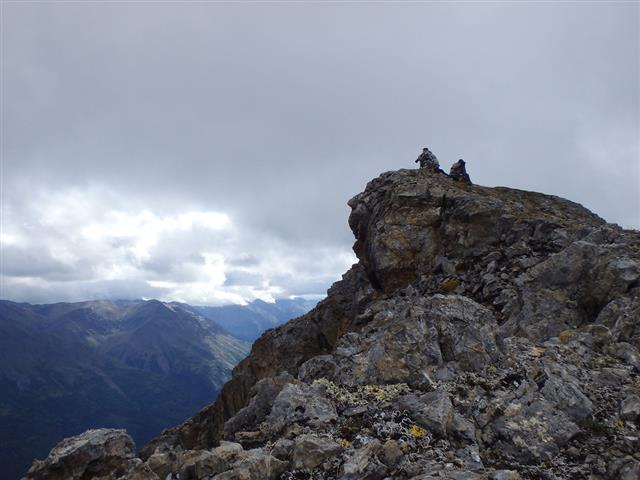
Typical terrain in the high country 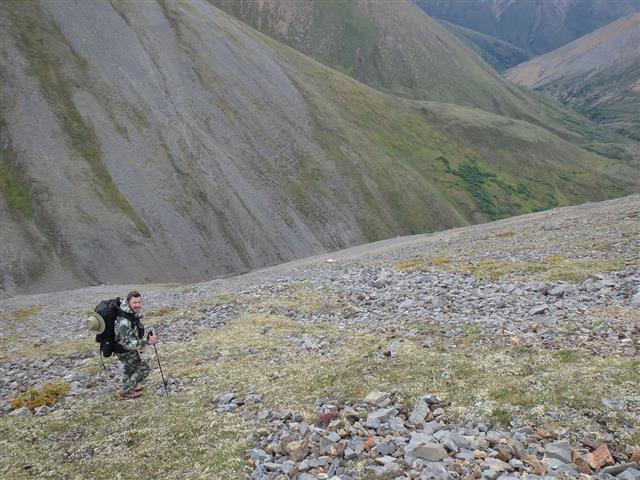
Headed down to a ram just shot by a hunter on what I would call a moderate slope. Camp is located across the valley below and back up a 1,000′ vertical climb, so we had already descended 1,000′ and climbed the opposite side of the valley for our first 1,000′ ascent. Total for the day; 2,000′ down and 2,000′ back up. A headlamp left in camp made this all the more tedious late in the night.
Ultimately all of the land in Alaska is different, thus very different degrees of difficulty. Hunting the beach on the Alaska Peninsula can be relatively easy, until you have to make a flat out sprint to try to catch up with a bear going the opposite direction. Sheep country, and caribou country are the same where we are at, and that is virtually all bad! The river bottoms are usually nightmarish alder and vegetation thickets and can be excruciating in their own right. Crossing wet tundra or moose swamps can challenge anyone’s sanity and packing game out is always the other huge consideration that one has to face before the trigger is pulled.
Physical Limitations
I have stressed the utmost importance of the right mindset, but I think I would be remiss if I didn’t mention the need for actually getting yourself ready physically for a wilderness hunt. I know what my body can handle even at this ripe old age of 52, the question is do you? I know I can still do a 20 mile death march if necessary in the bush and I came very close to that as recent as 2016. I had a former hunter questioning me about getting ready to do a sheep hunt and I knew his age, and his physical size, but over the phone I told him I didn’t want to know how much he weighed (though I knew it was close to 230 lbs.), but I only wanted to know how tall he was and I would tell him what I thought he needed to get his weight down to in order to really consider himself in viable sheep hunting condition. He said he was 5′ 8″ and I told him he needed to weigh no more than 170-180 lbs. Now mind you if you are a large frame guy this can vary quite a bit but a medium frame man that is 5′ 8″ tall is not ready for sheep if he is hauling over 200 lbs. before he puts a pack on. I’m 6′ 1″ and I abhor the idea of going into sheep camp weighing any more than 180-185 lbs. I much prefer 175 lbs. and most people think I look like I’m going to die at that weight, but they don’t have to pack the ram back out, or the moose, or the bear…you get the idea!
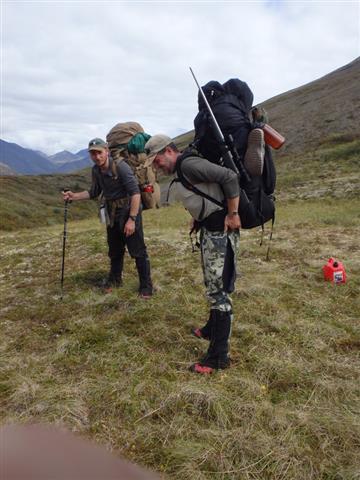
Aerobic exercise will do guys a lot better than focusing on strength training, because this is far more about heart and lung capacity than it is about brute strength, so run the stairs, hike the steepest slopes you can find if you have them, do it with the pack if you can. Even 30 lbs. in the pack will help tremendously and do everything possible to take the extra weight off if you have the time. I had a hunter start training the November before sheep season and by August of the following year he was running 100 miles per week and had dropped 30 lbs. Did he make it it? Yeah he packed out a 39″ ram from one of the worst sheep drainages I have ever had the privilege of hunting! So don’t shortchange yourself.
Use your gear, wear the boots and socks for goodness sake and get that pack fitted properly, which means the weight should not be on your shoulders but all on that hip belt. I personally pack a backpack that weighs in at 25 pounds or so every day in the field and I figured out a long time ago, that if I get my weight down from 195 lbs. to 175 lbs. before season then I almost complete nullify that pack’s weight. Nothing can substitute you pushing your body through some extremes as you prepare for hunting a place like Alaska, whether it be an actual 20 mile hike in rough country, running a 10K or more, or running every flight of stairs you see until the day your hunt begins. I can assure you of one thing, you are not likely to get out of the bush in Alaska and say I trained way too seriously for this hunt!